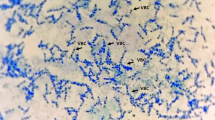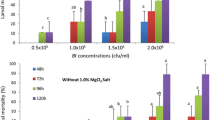Summary
A dark brown mutant ofBacillus thuringiensis H-14 (BT-MB24) and a macrofibre mutant ofBacillus sphaericus H5 ab (BS-MS3) were applied to mosquito breeding habitats such as rain-water pools, casuarina garden pits, paddy fields and cesspits. The population of these bacilli in the water and soil of these habitats was monitored. The results show that the population of the two bacteria recovered from the water decrease with simultaneous increase in the soil populations within one hour of application: by day 19, the bacilli are virtually absent from the water. Only a few cells remain viable in the water for up to 200 days and in the soil for up to 270 days. Even though both these bacilli persist in the waters for a long time at about 100 CFU mL−1 they do not cause any significant reduction in the mosquito larval density.
Similar content being viewed by others
References
Anon. 1979. World Health Organization. Data sheet on the biological control agentBacillus thuringiensis serotype H-14.WHO/VBC/79/750 Rev.
Anon. 1980. World Health Organization. Data sheet on the biological control agentBacillus sphaericus strain 1593.WHO/VBC/80.777.
Anon. 1965. Standard methods for the examination of waste water, 12th edition.American Public Health Association, New York.
Balaraman, K., Balasubramanian, M. and Manonmani, L.M. 1983. Field trial ofBacillus thuringiensis H-14 (VCRC B-17) Formulation as mosquito larvicide.Indian J. Med. Res.,77, 33–37.
Balaraman, K. and Hoti, S.L. 1987. A dark brown mutant ofBacillus thuringiensis H-14 synthesizing higher level of mosquito larvicidal factor.Ind. J. Med. Res.,85, 270–273.
Cheung, P.Y.K. and Hammock. 1985. Separation of three biologically distinct activities from the parasporal crystal ofBacillus thuringiensis var.israelensis activity characterization.Curr. Microbiol.,12, 37–41.
Davidson, E.W., Urbina, M., Payne, J., Mulla, M.S., Darwajch, Dulmage, H.T. and Correa, J.A. 1984. Fate ofBacillus sphaericus 1593 and 2362 spores used as larvicidal in the aquatic environment.Appl. Environ. Microbiol.,47, 125–129.
Hertlein, B.C., Levy, R. and Miller Jr., T.W. 1979. Recycling potential and selective retrieval ofBacillus sphaericus from soil in a mosquito habitat.J. Invertebr. Pathol.,33, 217–221.
Hornby, J.A., Hertlein, B.C., Levy, R. and Miller Jr., T.W. 1981. Persistent activity of mosquito larvicidalBacillus sphaericus 1593 in fresh water and sewage. WHO mimeography DocumentWHO/VBC/8/830.
Hoti, S.L. and Balaraman, K. 1984. Recycling potential ofBacillus sphaericus in natural mosquito breeding habitats.Ind. J. Med. Res.,80, 90–94.
Hoti, S.L. and Balaraman, K. 1989. Macrofibre mutants ofBacillus sphaericus H5 ab.Indian J. Med. Res. (In Press).
Myers, P.S. and Youston, A.A. 1980. Localization of mosquito larval toxin ofBacillus sphaericus 1593.Appl. Environ. Microbiol.,39, 1205–1211.
Paily, K.P., Virmani, A.K. and Jayachandran, S. 1987. Utility ofBacillus sphaericus in controllingCulex quinquefasciatus breeding.FEMS Microbiol. Ecol.,45, 313–318.
Teklehalmanot, A. and Williams, R.E. 1985. Larvicidal activity ofBacillus thuringiensis var.israelensis H-14 againstCulex pipens in swine waste lagoons.J. of the Florida Anti. Mosq. Cont. Assoc.,56, 1–5.
Yoshiharu, W., Masaki, E., Koizeemi, Niehimoto, Y., Endo, Y., Nirhimura, M.S. and Juuko, N.U. 1982. AsporogenousBacillus thuringiensis mutant producing high yields of endotoxin.Appl. Environ. Microbiol.,43, 1498–1500.
Author information
Authors and Affiliations
Additional information
The authors form part of the research team at the Vector Control Research Centre of the Indian Council of Medical Research, Indira Nagar, Pondicherry.
Rights and permissions
About this article
Cite this article
Hoti, S.L., Balaraman, K. Changes in the populations ofBacillus thuringiensis H-14 andBacillus sphaericus applied to vector breeding sites. Environmentalist 11, 39–44 (1991). https://doi.org/10.1007/BF01263197
Issue Date:
DOI: https://doi.org/10.1007/BF01263197




